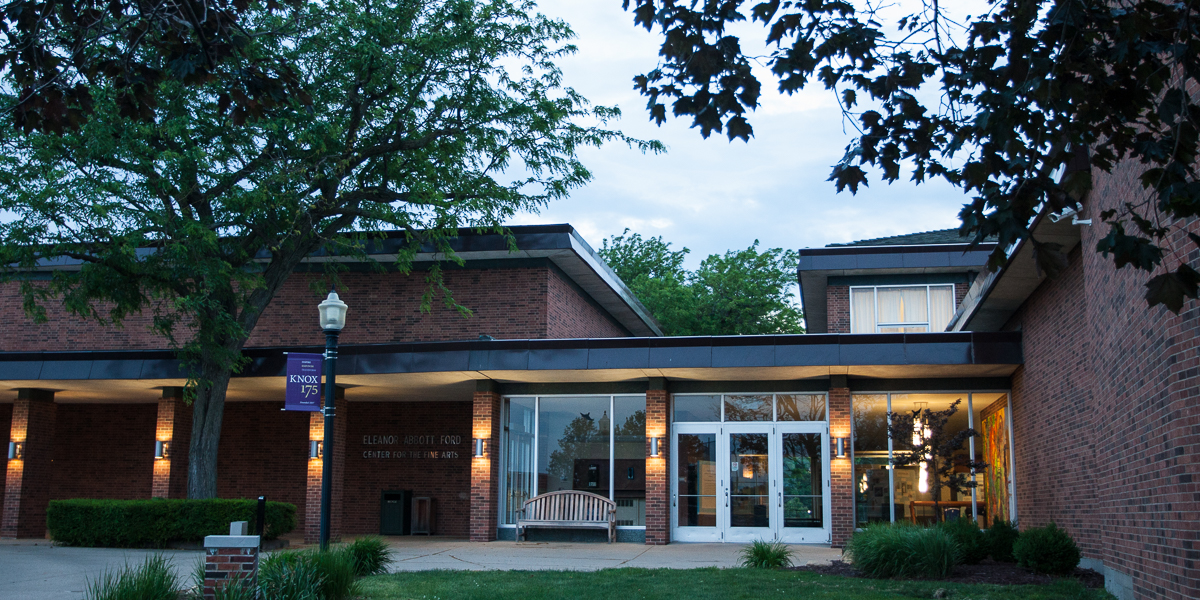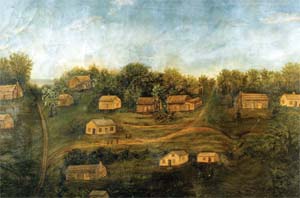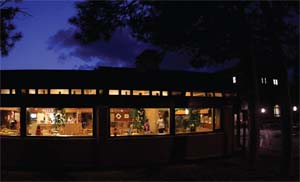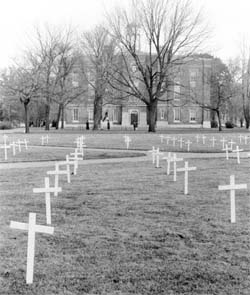


Compiled by Adriana Colindres, Megan Scott '96, and Cheri Siebken
There are certain events and moments in a college's history that make a lasting impact, remembered for generations by alumni, faculty, and staff. Some may be related to national or international events, such as war or depressions; others may be unique to the institution itself. But all enter the collective memory of the institution and help to shape its very culture and history. What better moment to reflect upon a few such moments in Knox College's history than its 175th birthday, and who better to explain why such moments have stood the test of time than those who experienced these events first-hand.

In the early fall of 1835, George Washington Gale, Silvanus Ferris, Thomas Simmons, and Nehemiah West left New York to purchase land to establish a college and a town in the Mississippi River Valley. The travel was not without dangers, as their steamboat was struck during a storm on Lake Erie, and Gale became so ill that he had to be left behind in Detroit. But on October 15, the wagon train arrived on the Illinois prairie, where the men plotted out and purchased the land that would become the community of Galesburg and Knox College. In a letter to relatives written upon his return from the expedition, Nehemiah West described the land that he says induced him to tear himself from dear friends and the bosom of his family.
"We proceeded to Illinois, and, after examining all the places visited by the committee in the spring, we selected a location in the county of Knox, lying nearly central between the Illinois and Mississippi rivers, in the Military Tract, 150 miles southwest from Chicago and about 40 miles west of Peoria. We purchased about 20,000 acres, nearly in a square form, mostly prairie.
It is a fine tract of land in a very healthy country, well watered, and supplied with abundance of stone and coal. We surveyed it out into lots of 80 acres each, agreeable to our plan of distribution among subscribers. In the center we laid off three continuous sections of 640 acres each, for college and village purposes -- two for the college and one for the village -- stuck the stakes for our college building and returned home.
We have about 30 families -- all pious -- who are to settle together, so you see we have the prospect of good society, and the facilities for educating our children."
 There is perhaps no other event in Knox College's history that has brought it more national and international acclaim than the debate between Abraham Lincoln and Stephen Douglas that took place on the east side of Old Main on October 7, 1858. More than 10,000 people witnessed the debate, but few had as good a seat as the Reverend N.T. Allen, who attended the Knox Academy from 1860 to 1865. A boy of only 14 in 1858, Allen was able to work his way to the platform itself and bear witness to the orations of the future 16th president of the United States. Upon the 50th anniversary of the debate, the Reverend Allen recounted the events of the day:
There is perhaps no other event in Knox College's history that has brought it more national and international acclaim than the debate between Abraham Lincoln and Stephen Douglas that took place on the east side of Old Main on October 7, 1858. More than 10,000 people witnessed the debate, but few had as good a seat as the Reverend N.T. Allen, who attended the Knox Academy from 1860 to 1865. A boy of only 14 in 1858, Allen was able to work his way to the platform itself and bear witness to the orations of the future 16th president of the United States. Upon the 50th anniversary of the debate, the Reverend Allen recounted the events of the day:
"I attended the great debate in Galesburg, Oct. 7, 1858. I came from Center Point very early in the morning and went with the crowd half way to Knoxville to meet him.... While the flag was being presented to Lincoln, I made my way to the place where the speaking was to be and a good position on the south east corner of the platform, and sat there for three hours, or very nearly so, for Lincoln did not take the full hour and a half allotted to him.
I sat within six or eight feet of Lincoln and watched closely the expression of his countenances. Douglas gave in his first hours' talk what seemed to be ‘hot shot,' and while this debate was more of a review of former debates than the presentation of new ideas, I wondered if Lincoln would satisfactorily answer or explain, and I remember the twinkle in his eye and the stern expression of his countenance when he rose to reply. And how completely he answered every question without evasion, and how cutting were his words, and how the very soul of Douglas was stirred with wrath at his minute and detailed description of the attitude taken by Douglas on the great questions that were agitating the public mind and conscience."
Retired teacher Maurice Stamps '39 was a Knox student when the College observed its Centennial and rededicated Old Main in 1937. Celebratory activities included a June 15 speech by Carl Sandburg and a Centennial Pageant depicting key events in Knox's then 100-year history. Stamps worked various jobs during the year-long celebration, washing dishes or patrolling pageant grounds, and recently shared a few new insights into what occurred behind the scenes during this landmark campus celebration.
"I saw Carl Sandburg give [his] speech. I was there because the athletic director, Dean Trevor, had appointed me to pick up trash and keep the  ground clean around the Centennial activities on campus and also at Lake Storey Park, where every night for a week they held a Centennial Pageant.
ground clean around the Centennial activities on campus and also at Lake Storey Park, where every night for a week they held a Centennial Pageant.
I even stayed out at the Pageant site at night to make sure no one bothered the Pageant materials. There were a lot of borrowed artifacts, which included a covered wagon that Henry Ford had loaned the College from his Dearborn museum. The wagon had been made by a master wagon-maker in Ohio named Custer, and his son, General George Armstrong Custer, had used that wagon to carry his personal gear on his ill-fated trip to the Little Big Horn!
One afternoon, Carl Sandburg came out to the Pageant site with some of the College officials. He was very much interested in the wagon, so I actually got to exchange a few words with the great man! What a thrill it was to me to actually get to talk to Carl Sandburg. He was already a hero of mine because of his poem, "Chicago," as well as his other writings, and because he was a Galesburg native whom Lombard and Knox [Colleges] claimed as their own.
I also had a meal job at Seymour Hall. The College had a set of china that had been used when Abraham Lincoln came to visit. I am not sure if that was at the time of the Lincoln-Douglas debate or some other time. During my years at Knox, it was only used when the board of regents or other VIPs dined. Miss Grubb, the College dietitian, picked me to wash and dry the Lincoln china after it had been used [at a luncheon]. I spent a full half-day doing it -- one piece at a time, carefully!"
There are a few days that will never be forgotten by most Americans, whether we lived through them or not -- December 7, 1941, is one of them. Marye McElvaine Immenhausen '45 was on campus when Pearl Harbor was bombed and remembers what it was like to attend Knox during World War II, when most of the college's male students left to serve in the military.
 "My first two years in college were perfectly normal, like anybody would expect. And then there was Pearl Harbor. [That day,] we came over to the parlor of Seymour Hall, and we listened to the declaration of war on the radio with a bunch of students. The guys were thinking, ‘What is our role? What do we do?' Parents were calling. We were numb. There was shock.
"My first two years in college were perfectly normal, like anybody would expect. And then there was Pearl Harbor. [That day,] we came over to the parlor of Seymour Hall, and we listened to the declaration of war on the radio with a bunch of students. The guys were thinking, ‘What is our role? What do we do?' Parents were calling. We were numb. There was shock.
A lot of people went home that weekend. They wanted to talk with their family and talk with their parents and figure out who they were or what was expected of them. This was a time when people kind of hung together, they shared with each other, they wondered with each other. We hadn't lived through a war, any of us. And we were young adults. We had a role, we thought, but we didn't quite know what it was.
There was just a lot of worry, a lot of questioning. Knox was great. There were people available to talk, and they formed little groups of people who had common worries, common concerns. They offered whatever there was to offer. The College tried to tweak the system as much as they could to keep those of us who wanted to stay in school as long as we could -- the guys, especially.
There was seriousness behind all of the efforts. ‘Will I finish college?' some thought. As some would volunteer and go away, those of us who remained thought, ‘Will I see them again?'
Our guys were gone, but we had Air Cadets that were platooning around the campus, marching from class to class, singing their songs. Many of us were dating some of them. We tried to entertain them and make it a nice time, and if something developed, fine. If something didn't, it didn't. Then pretty soon, they'd ship out and go to San Antonio or wherever they got shipped to, and then we'd have a fresh crop.
We all got through it. I hope somehow we learned from it."
Phyllis Holowaty Albrecht '56 was a junior in October 1954, when three fellow Knox students -- members of Beta Theta Pi fraternity -- died as a result of an auto accident while returning to campus from nearby Lake Bracken. A few months earlier, in March, two other male students had died in a separate traffic accident near the Quad Cities. In response to the accidents, the College banned all students from having cars on campus and began efforts to build more opportunities for student activities in a centralized space. As a member of the student council, Phyllis was actively involved in these developments and remembers what it was like to be on campus during this time of grief and change. She recalls student resentment and incidents of protest against the ban.
"When thinking back upon the events surrounding the accidents, my husband, Jim Albrecht '54, reminded me that when he was a freshman, a lot of the seniors in the fraternities were returning veterans. When they came back to school in the late '40s, they came back with a different idea of lifestyle. There was a culture of drinking, and it probably had escalated in the Post-War period.
I think about the fact that both of the car accidents involved men only. Women had a very sequestered
lifestyle at Knox in the '50s. We lived in Whiting Hall, and the overflow from Whiting Hall for senior women and some junior women was to go to what they called the outhouses, which were a row of lovely old Queen Anne and Victorian houses that were on Tompkins Street.
By and large, it was a two-tier society in terms of social life. Women were very controlled and sheltered with strict curfews, and the men were really not at all regulated. And there was no student union.
All I recall about 1954 was shock, disbelief, and grief. I think most of us probably suppressed a lot of the awful details of the accidents themselves, and part of that is just the mindset of young people -- death is unacceptable; you can't even contemplate it.
I would say that the College made a very hasty attempt to create a student gathering space, and the nucleus of that effort was to dedicate one room in Seymour Hall to students. I really think the administration reached out because they were in as big a state of shock as the students were.
 Another aftereffect of this was the student council became more empowered. I happened to run for president of the student council and was elected in my junior through senior years. One of the things we created was the position of a social coordinator. The whole idea was for students to have some input in creating more social opportunities on campus.
Another aftereffect of this was the student council became more empowered. I happened to run for president of the student council and was elected in my junior through senior years. One of the things we created was the position of a social coordinator. The whole idea was for students to have some input in creating more social opportunities on campus.
Maybe we were just one bubble on the surface of the geyser, and, without knowing it, we were part of just a general trend of thinking where students and young people were going to become more assertive, more politically active, more interested in vocalizing and bringing about change. For me, that time represented the seed for creating more hospitable, diverse opportunities on campus for students to get together and spend their free hours. And when you look around Seymour today, you realize that the seed took hold, and it did bring about a revolutionary change in the way the building is used."
 Knox students woke up on Election Day, November 5, 1968, to find a changed campus. Crosses were lined up and down the South Lawn; soldiers stood in front of every door into Seymour Union; an image of Che Guevara adorned the south wall of Old Main; and, most horrifying of all, a lynch victim swung from the limb of a tree. This, the College's first display of "guerrilla theatre," was organized by a group of roughly 40 students -- who had the support of the Student Senate -- hoping to encourage student attendance at the day's lectures, which focused on racism, war, and the national election. The event's organizers felt the demonstration was a success. How did other members of the Knox community react? The Knox Student captured the many reactions to the day.
Knox students woke up on Election Day, November 5, 1968, to find a changed campus. Crosses were lined up and down the South Lawn; soldiers stood in front of every door into Seymour Union; an image of Che Guevara adorned the south wall of Old Main; and, most horrifying of all, a lynch victim swung from the limb of a tree. This, the College's first display of "guerrilla theatre," was organized by a group of roughly 40 students -- who had the support of the Student Senate -- hoping to encourage student attendance at the day's lectures, which focused on racism, war, and the national election. The event's organizers felt the demonstration was a success. How did other members of the Knox community react? The Knox Student captured the many reactions to the day.
"Certainly the initial shock of seeing Knox occupied by the military disturbed some of us; yet, as soon as the make-believe aura of the whole thing became known, thoughts began to wander. People started to think of the elections in terms of who's winning, who's the bigger threat to our security. As with most successful dramatic representations, feelings about the Guerrilla Theatre were discussed by many of the viewers. As the play's impact fades one is left with reality. With the end of the Guerilla Theatre performance, we were left with Richard Nixon as president." -- The Knox Student
"Hats off to those responsible for the election-day stunts on campus. Perhaps shock therapy is the cure for apathy. At any rate, many students were forced to take a long, hard look at what is happening in the nation and world." -- Viva la paz, A Concerned Junior
 On Saturday, November 4, 1989, the Knox and Monmouth College football teams took to the field in the Knox Bowl for the 100th Bronze Turkey game -- the sixth oldest football rivalry in the nation. It was a warm fall day, and the Bowl was filled to capacity with a crowd of 6,000 fans ... and one live turkey, thanks to a prank by a few Knox BETAs. It was the last game Chad Eisele '93, Knox's director of athletics, would play as a member of his alma mater's football team, and his teammates voted him the recipient of the Tom Dean Award, recognizing the most valuable player in the Knox-Monmouth game.
On Saturday, November 4, 1989, the Knox and Monmouth College football teams took to the field in the Knox Bowl for the 100th Bronze Turkey game -- the sixth oldest football rivalry in the nation. It was a warm fall day, and the Bowl was filled to capacity with a crowd of 6,000 fans ... and one live turkey, thanks to a prank by a few Knox BETAs. It was the last game Chad Eisele '93, Knox's director of athletics, would play as a member of his alma mater's football team, and his teammates voted him the recipient of the Tom Dean Award, recognizing the most valuable player in the Knox-Monmouth game.
"From a player's point of view, there was a big buildup for this game all year. We talked about it throughout the entire season. There were rumors at one point that ESPN was going to come and broadcast the game. The other rumor was that President Bush was trying to work it into his schedule so that he could be here for the game. He'd been here on campus before (a stop during the 1988 presidential campaign). The other exciting thing that happened that week was that the original Bronze Turkey trophy that was stolen got returned to Monmouth on Friday evening. It just showed up! We were all very excited.
I can tell you that it was the most exhilarating time that I've ever had running onto a field, and it was a great game. The score was 0 to 0 with less than 10 minutes to go. We turned the ball over offensively inside the 20 yard line, and Monmouth scored with about five minutes left. We got the ball back and threw an interception inside the 20. They got the ball back, and it ended up being a 14-0 game. But up until the last 5 minutes, it was certainly neck and neck, and a game that the crowd was really into. Of all the games I've ever played -- I've won state championships as a player, and I've won conference championships as a coach -- that game was the most exciting experience that I ever had, even though we lost. I'll never forget it."
 The events of September 11, 2001, unfolded on the Knox campus much as they did around the world. High aspirations for a beautiful fall day turned to disbelief, horror, and sadness as Knox faculty, students, and staff watched and mourned from afar. Students organized a candlelight vigil, which drew more than 100 members of the Knox community. Three days later, Galesburg's Central Congregational Church hosted a community vigil, and among the speakers was Sahar Zaidi '02, an international student from Pakistan and president of the Islamic Club.
The events of September 11, 2001, unfolded on the Knox campus much as they did around the world. High aspirations for a beautiful fall day turned to disbelief, horror, and sadness as Knox faculty, students, and staff watched and mourned from afar. Students organized a candlelight vigil, which drew more than 100 members of the Knox community. Three days later, Galesburg's Central Congregational Church hosted a community vigil, and among the speakers was Sahar Zaidi '02, an international student from Pakistan and president of the Islamic Club.
"We, the students representing the cultural, religious, and civic organizations of Knox College, wish to offer our most sincere and heartfelt condolences to all of those people who have lost loved ones in the catastrophic events of September 11, 2001.
This shameful act represents an attack against democracy, civilization, and peace-loving people everywhere. We, as a community, wish to affirm that these barbaric actions have failed in their objectives. Instead of inciting fear and hatred, our resolve has become only more united and steadfast.
In the events of the past few days, it is becoming increasingly more apparent that the global community faces a challenge unlike anything that has ever been encountered before. The forces of terror, hatred, and violence have drawn a line that can only be overcome by our unified commitment to peace, love, and justice. We cannot avoid fear, but we can avoid intolerance, injustice, and hatred within our ranks. The perpetrators of this heinous act must be brought to justice; however, we can never achieve true victory over the forces of hate if we forget the essential foundations this nation was built upon. Our diversity and our capacity to love and respect people of every faith and creed is the cornerstone that makes our society a symbol of liberty for all.
Women and men of all faiths stand together in mutual understanding and solidarity as a nation and as a world. We must remember that this act of terror in no way represents the principles of the Islamic faith -- or ANY faith for that matter.... Regardless of religious affiliations and ethnicity, all people of faith must rely on our love of peace and humanity to carry us through this dark hour."
1968
A.B.L.E. (Allied Blacks for Liberty & Equality) was founded.
Open to students of all races, uniting them around common concerns regarding the Black experience